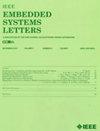GNN-MiCS: Graph Neural-Network-Based Bounding Time in Embedded Mixed-Criticality Systems
IF 2
4区 计算机科学
Q3 COMPUTER SCIENCE, HARDWARE & ARCHITECTURE
引用次数: 0
Abstract
In mixed-criticality (MC) systems, each task has multiple WCETs for different operation modes. Determining WCETs for low-criticality modes (LO modes) is challenging. A lower WCET improves processor utilization, but a longer one reduces mode switches, maintaining smooth task execution even with low utilization. Most research focuses on WCETs for the highest-criticality mode, with fewer solutions for LO modes in graph-based applications. This letter proposes GNN-MiCS, a machine learning and graph neural networks (GNNs) scheme to determine WCETs for directed acyclic graph applications in LO modes. GNN-MiCS generates test sets and computes proper WCETs based on the application graph to enhance system timing behavior. Experiments show our approach improves MC system utilization by up to 45.85% and 22.45% on average while maintaining a reasonable number of mode switches in the worst-case scenario.嵌入式混合临界系统中基于图神经网络的边界时间
在混合临界(MC)系统中,每个任务都有多个wcet用于不同的操作模式。确定低临界模式(LO模式)的WCETs具有挑战性。较低的WCET可以提高处理器利用率,但较长的WCET可以减少模式切换,即使在低利用率的情况下也能保持任务的平稳执行。大多数研究都集中在最高临界模式的wcet上,而基于图的应用程序中LO模式的解决方案较少。这封信提出了GNN-MiCS,这是一种机器学习和图神经网络(gnn)方案,用于确定LO模式下有向无环图应用程序的WCETs。GNN-MiCS生成测试集,并根据应用程序图计算适当的wcet,以增强系统定时行为。实验表明,我们的方法在最坏情况下保持合理的模式切换数量的同时,平均可将MC系统利用率提高45.85%和22.45%。
本文章由计算机程序翻译,如有差异,请以英文原文为准。
求助全文
约1分钟内获得全文
求助全文
来源期刊

IEEE Embedded Systems Letters
Engineering-Control and Systems Engineering
CiteScore
3.30
自引率
0.00%
发文量
65
期刊介绍:
The IEEE Embedded Systems Letters (ESL), provides a forum for rapid dissemination of latest technical advances in embedded systems and related areas in embedded software. The emphasis is on models, methods, and tools that ensure secure, correct, efficient and robust design of embedded systems and their applications.
 求助内容:
求助内容: 应助结果提醒方式:
应助结果提醒方式:


